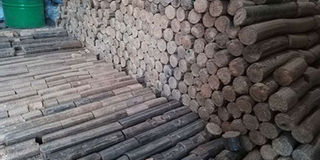Poop briquettes save trees

Super-logs manufactured through Sanivation, a process of changing human waste into briquettes to be used as firewood. PHOTO | COURTESY
What you need to know:
- Besides biofuel, Nawasscoal has been critical in Nakuru in ensuring there is no indiscriminate discharging of human waste.
- If the company could produce 300 tonnes of briquettes per month, it will be saving 26,400 trees in that period of time.
Most people would rather not think or hear about human waste and understandably so.
But, innovations have proved human waste can generate wealth, save trees, conserve water sources and the environment in general.
In Nakuru for example, human waste is used to make briquettes and soon will be used to produce methane. Gradually, the use of biofuel made from human waste is replacing charcoal and firewood.
John Irungu, the general manager of Nawasscoal, told HealthyNation a research they did with Egerton University and University of Nairobi established that one tonne of human sludge briquettes could save 88 trees of average size.
He said if the company could produce 300 tonnes of briquettes per month, it will be saving 26,400 trees in that period of time.
The innovation came about after the government banned logging and charcoal burning as a way of conserving forests.
GREEN ENERGY
The company focuses on green energy technologies geared towards conserving the environment.
It makes human sludge briquettes and, in the process, produces methane and tar, by-products which are useful in the community.
Methane is used for heating and lighting while tar is used during tarmacking of roads. “We’re looking at various products that we could make out of human waste from the five-year research. Some were bio-fertilisers, pellets and the biofuel briquettes,” Irungu said.
“From the analysis, we found that human waste could make all those. But, the research project was coming to an end when the government had put in place measures to stop logging and burning of charcoal. We decided that the immediate need for the public was charcoal because they did not have an alternative,” he said.
During the production, they combine 50 percent human waste and 50 percent sawdust to make the briquettes through a rigorous process.
AFFORDABLE
The matter is dried and burnt to 400 degrees Celsius to remove disease-causing micro-organisms. The substance is then crashed to a fine powder before making balls using molasses as a binder.
The balls are then dried for several days and packed ready for sale. A two-kilogramme pack of the briquettes is Sh60 and is able to burn up to three hours.
The company is in the process of setting up a methane production plant from faecal matter, besides the briquettes.
With this, trees will be preserved because no charcoal or wood will be needed for lighting or heating, Irungu observed.
Besides biofuel, Nawasscoal has been critical in Nakuru in ensuring there is no indiscriminate discharging of human waste.
WASTE DISPOSAL
The company uses both sewered and non-sewered human waste discharged by exhauster trucks and emptiers at a point near the plant.
“The way they were disposing of human waste has changed. We have been working closely even with manual pit emptiers, who used to empty the pits at night and dump the waste illegally in the open drainage system. Currently, they are collecting it safely and this ensures the environment is clean,” said Mr Irungu.
“We are getting more sludge than we used to get before. Where was that waste going before? Of course into open drainage systems and the lake, causing poor sanitation related diseases,” he added.
Several kilometres away in Naivasha, Sanivation, another social enterprise, has been changing human waste into briquettes.
Sanivation taps human waste at the household level by using a Blue Box portable toilet which utilises a bucket and a jerrican placed inside the plastic container.
The bucket and the jerrican are placed in a way that ensures urine and faecal matter do not mix when a person uses it.
CONSERVATION EFFORTS
After harvesting the human waste, it is collected and taken for a series of processes which include drying and burning the sludge at 100 degrees Celsius to remove pathogens and then carbonising it before making briquettes.
Besides the lumps, the waste could also be mixed with other by-products like sawdust to make non-carbonised super-logs, which are used in factories and industries instead of firewood.
While the government is focused on increasing the forest cover by 10 percent by 2022, such initiatives will boost the campaign, said Winnie Guchu, Chief Administrative Secretary in the Water and Sanitation ministry.


